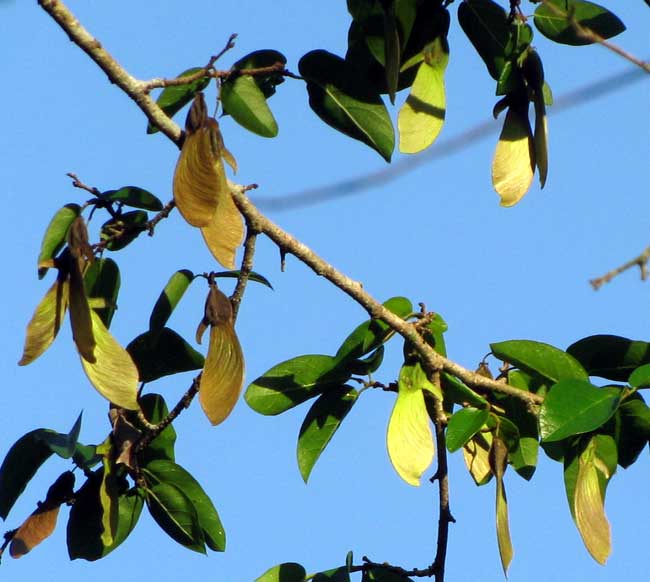Excerpts from Jim Conrad's
Naturalist Newsletter

from the March 20, 2011 Newsletter issued from Hacienda Chichen Resort beside Chichén Itzá Ruins, central Yucatán, MÉXICO; limestone bedrock, elevation ~39m (~128ft), ~N20.676°, ~W88.569°
MYSTERY TREE UNVEILED
A year ago a certain tree not far from the hut began fruiting and I just couldn't figure out what it was -- not even which plant family it belonged to. You can see a branch with its simple leaves and winged fruits above.
The leaves look almost like those of a cherry or pear tree while the dangling fruits are very similar to those of maple trees. A fruit close-up is shown below:

Those winged, inch-long (2.7 cm) fruits don't open when they mature, so they're known technically as samaras, same as with maple fruits. Unlike maple samaras, however, each fruit of this mystery tree bears two wings, one of them much smaller than the other and opposite it. In fact it looks as if originally each flower produced two winged samaras, but then one aborted, leaving the other to dominate. I've never seen anything like this.
Now a year after this tree began mystifying me it's fruiting again and this time I've been so desperate for an identification that I used a technique usually tried only by rank beginners: I began considering every plant family known to exist in this area, one at a time, asking myself if the mystery tree possibly could belong in that family. If I thought it might, I went to a family-by-family listing of the plants of the neighboring state of Quintana Roo, and if I didn't recognize a species in that family, I'd look for pictures of it on the Internet. I began with Acanthaceae, then Aceraceae...
By the time I came to Ulmaceae, the Elm Family, already I was feeling defeat. But I was determined to continue slogging through one taxon after another, all the way through Zygophyllaceae. Well, how about that Elm Family? In fact, elms do have papery-winged fruits so it was a possibility. In Quintana Roo there's a genus I didn't recognize, Phyllostylon, so I looked it up... BINGO!
The mystery tree is PHYLLOSTYLON BRASILIENSE, a member of the Elm Family, and now that I think of it the leaves are a little elmy, so why not? The species is not well documented on the Internet and appears to occur in dry, brushy forests in widely separated populations in the American tropics -- southern Mexico and Guatemala, the Caribbean, and here and there in South America.
One English trade name for Phyllostylon brasiliense has been San Domingan Boxwood, the tree's wood being exceptionally hard, heavy and compact, with a very fine and uniform texture, and a straight grain, making it easy to carve and apply a high polish to. In the past it was exported from the Dominican Republic to the US for use in making weaver's shuttles, rulers, and piano keys.